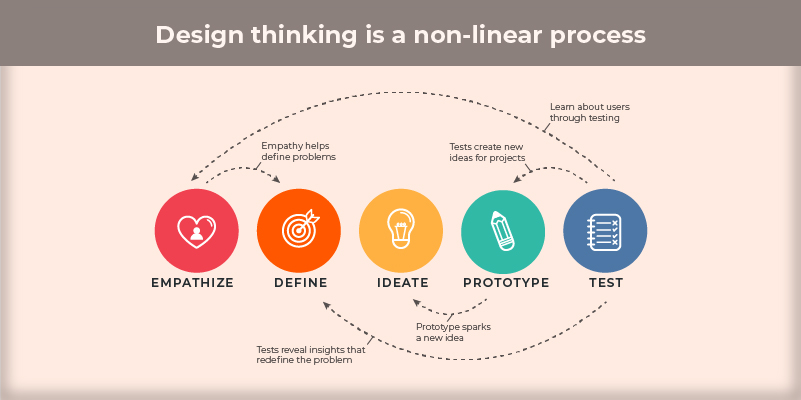Innovation is the cornerstone of progress, and creativity fuels the solutions that shape our future. In an ever-changing world, how do we prepare students not just to adapt but to thrive? Design thinking is a dynamic approach that empowers learners to tackle challenges with sharpness and confidence.
Research shows that students engaged in the design cycle exhibit higher-order thinking skills compared to those participating in traditional learning methods (Razzouk, 2012). Beyond fostering creativity, design thinking equips students with a mindset primed for solving complex, interdisciplinary problems—an essential skill set for navigating the uncertainties of the modern age.
This blog explores the transformative power of design thinking in education and how it enables students to think critically, act innovatively, and embrace challenges as opportunities.
What is Design Thinking?

Design thinking in the simplest of terms means thinking like a designer. It means putting the user (one who benefits from the solution) first, being open to new ideas, and constantly improving through feedback. It involves experimentation in a low-risk environment.
Traditional academic teaching and learning are typically analytical and focused. Design thinking encourages learners to take an inquiry stance, think divergently, and develop reflexivity. This approach affirms empathy, curiosity, constructiveness, and continuous iteration.
Design thinking is a structured approach to identifying challenges, gathering information, generating potential solutions, refining ideas, and testing solutions. This process is circular by nature and demands iteration. Each stage in the process should be revisited and invoked throughout a learning experience to encourage experimentation, solution feasibility, and reflection. (Ineta, 2014)
Stages of Design Thinking

Design thinking is a framework of five stages that are not always sequential. You can run them in parallel, out of order, and repeat them as needed. The iterative process allows the individual to bring back more information to earlier stages and redefine their solutions.
The five stages are as follows:
-
- Empathizing: Understanding the needs, values, and beliefs of the target audience
- Defining: Identifying the problem to be solved by piecing together findings from the empathize phase.
- Ideating: Creating potential solutions using brainstorming techniques (challenging assumptions).
- Prototyping: Narrowing down ideas and prioritizing the ones that will bring the most value.
- Testing: Evaluating concepts and prototypes to see how it works in real life (might bring about new insights and redefinition).
In industry settings, the design thinking process often aims to meet the following criteria:
- Desirability: Meeting the needs of the user
- Feasibility: Ensuring that solution is technically possible to build
- Viability: Ensuring the maker can profit from the solution
Traditionally, companies start by assessing feasibility or viability and then look for a problem that fits the solution to push it to market. In contrast, design thinking flips this approach, urging teams to first focus on desirability before considering feasibility and viability.
How Design Thinking Enhances Problem-Solving Skills Among Students

Design thinking encourages students to approach challenges with creativity, empathy, and a structured methodology. it can be flexibly implemented as a framework for a course design or a roadmap for an activity or a group project.
Here’s how:
- Empathy-based Problem Solving: It starts with understanding the needs and perspective of others. Helping students to develop empathy and come up with solutions that genuinely address real-world problems.
- Encouraging Critical Thinking: By identifying problems early, following the framework, you can break them down into simpler parts. This analytical approach enhances critical thinking.
- Fosters Creativity and Innovation: The Brain storming stage embraces divergent thinking without looking for one right answer. It builds the learner’s ability to think outside the box and innovate.
- Hands-On Learning Through Prototyping: This helps students create tangible versions of their ideas, helping them understand practical implications.
- Resilience and Adaptability: Iterative testing builds resilience, encouraging students to learn from their failures and improve.
- Collaborative Skills: Working in teams to solve problems nurtures collaboration, communication and trust among peers. All of these are critical to solve problems in the real world.
Applying Design Thinking in Classrooms

Design thinking improves the educational experience of students helping them see the world from a fresh, innovative perspective. It empowers educators to tailor their teaching methods to meet individual learning styles and needs. This gives rise to a more inclusive and effective learning environment. Using design thinking, students also undergo a mindset shift in how they tackle problems in all areas of life.
Hands on Learning:
Design-based projects and activities engage students in teamwork, exploring new ideas and connecting with relevant people and places to build and test tangible solutions. Design thinking allows for highly collaborative activities in and out of the classroom keeping students actively engaged.
Flexible Application:
Design thinking proves equally impactful across all scales, from activities and projects to courses and program level. It can be used as a component of another methodology or on its own over several months. One can study it directly as an approach or in pursuit of other academic work.
The Design Thinking Stages Applied to Education:
- Empathize: It encourages educators by empathizing with students’ needs. They can now tailor their teaching methods to be more personalized and responsive.
- Define: By identifying learning objectives and challenges faced by students, educators can create targeted and effective teaching strategies.
- Ideate: This stage encourages a culture of brainstorming and creative thinking. Students express ideas freely, leading to diverse solutions.
- Prototype: Students can create prototypes of their learning solutions. involves creating projects, presentations, interactive activities (hands on learning and experimentation)
- Testing: This stage emphasizes an iterative approach, where students are encouraged to receive feedback gracefully, reflect on their work, and continuously improve. The iterative cycle fosters a growth mindset and resilience in the face of challenges.
Innovation Fest to Build 21st-century Skills Among Students

Innovation fests serve as powerful platforms for students to apply their knowledge, channel their creativity, and test their problem-solving abilities in real-world scenarios. Events like FIRST Robotics Competition, RoboCup, and Google Science Fair are not just competitions; they are opportunities for students to think critically, collaborate, and develop innovative solutions to complex problems.
These fests exemplify the principles of design thinking. Students engage in the full cycle—from empathizing with a target audience or problem, defining objectives, brainstorming ideas, building prototypes, and testing their solutions. This hands-on experience not only deepens their understanding of design thinking but also fosters essential 21st-century skills such as adaptability, collaboration, and resilience.
One such innovation fest that embodies these values is Codeavour, an annual AI, coding, and robotics competition hosted by STEMpedia. Codeavour provides young minds with an inspiring stage to explore cutting-edge technologies while applying design thinking to create impactful solutions. Through challenges rooted in real-world issues, students have the chance to innovate, iterate, and showcase their skills to a global audience.
Students experience the transformative power of design thinking firsthand by participating in innovation fests. They gain skills that prepare them for the demands of the modern workforce. Such events serve as a testament to the potential of design thinking in shaping the next generation of problem-solvers and innovators.
In a Nutshell
Design thinking is more than just a problem-solving tool; it’s a transformative approach that equips students with the skills, mindset, and resilience needed to navigate the complexities of the modern world. This hands-on, iterative process not only enhances students’ academic experience but also prepares them for real-world challenges.
As we continue to integrate design thinking into education, we open the door for students to think critically, collaborate effectively, and embrace failure as a valuable learning experience. In doing so, we prepare them not just to adapt to change, but to lead it, armed with the problem-solving skills they need to succeed in an ever-evolving world.









